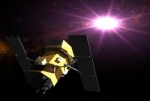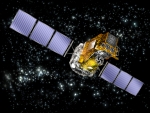Displaying items by tag: gamma_ray
Fermi Gamma-ray Space Telescope
The Fermi Gamma-ray Space Telescope (FGST), formerly called the Gamma-ray Large Area Space Telescope (GLAST), is a space observatory being used to perform gamma-ray astronomy observations from low Earth orbit.
Its main instrument is the Large Area Telescope (LAT), with which astronomers mostly intend to perform an all-sky survey studying astrophysical and cosmological phenomena such as active galactic nuclei, pulsars, other high-energy sources and dark matter. Another instrument aboard Fermi, the Gamma-ray Burst Monitor (GBM; formerly GLAST Burst Monitor), is being used to study gamma-ray bursts.
Fermi was launched on 11 June 2008 aboard a Delta II 7920-H rocket. The mission is a joint venture of NASA, the United States Department of Energy, and government agencies in France, Germany, Italy, Japan, and Sweden.
Compton Gamma Ray Observatory (CGRO)
The Compton Gamma Ray Observatory (CGRO) was a space observatory detecting light from 20 KeV to 30 GeV in Earth orbit from 1991 to 2000.
It featured four main telescopes in one spacecraft covering x-rays and gamma-rays, including various specialized sub-instruments and detectors. Following 14 years of effort, the observatory was launched on the Space Shuttle Atlantis, mission STS-37, on 5 April 1991 and operated until its deorbit on 4 June 2000. It was deployed in low earth orbit at 450 km to avoid the Van Allen radiation belt.
Swift Gamma-Ray Burst Mission
The Swift Gamma-Ray Burst Mission consists of a robotic spacecraft called Swift, which was launched into orbit on 20 November 2004.
Swift is managed by the NASA Goddard Space Flight Center, and was developed by an international consortium from the United States, United Kingdom, and Italy. It is part of NASA's Medium Explorer Program (MIDEX).
Swift is a multi-wavelength space observatory dedicated to the study of gamma-ray bursts (GRBs). Its three instruments work together to observe GRBs and their afterglows in the gamma-ray, X-ray, ultraviolet, and optical wavebands.
Based on continuous scans of the area of the sky with one of the instrument's monitors, Swift uses momentum wheels to autonomously slew into the direction of possible GRBs. The name "Swift" is not a mission-related acronym, but rather a reference to the instrument's rapid slew capability
High Energy Stereoscopic System (HESS)
The High Energy Stereoscopic System (H.E.S.S.) is a next-generation system of Imaging Atmospheric Cherenkov Telescopes (IACT) for the investigation of cosmic gamma rays in the 100 GeV and TeV energy range. The acronym was chosen in honour of Victor Hess, who was the first to observe cosmic rays.
The name also emphasizes two main features of the currently-operating installation, namely the simultaneous observation of air showers with several telescopes, under different viewing angles, and the combination of telescopes to a large system to increase the effective detection area for gamma rays.
H.E.S.S. permits the exploration of gamma-ray sources with intensities at a level of a few thousandth parts of the flux of the Crab Nebula. H.E.S.S. has four telescopes, each with a mirror just under 12m in diameter, arranged 120m apart from each other in a square. A larger telescope with a 30m mirror called H.E.S.S. Phase 2, constructed in the centre of the array, saw its first light at 0:43 a.m. on 26 July 2012.
As with other gamma-ray telescopes, H.E.S.S. observes high energy processes in the universe. Gamma-ray producing sources include supernova remnants, active galactic nucleii and pulsar wind nebulae. It also actively tests unproven theories in physics such as looking for the predicted gamma-ray annihilation signal from WIMP dark matter particles and testing lorentz invariance predictions of loop quantum gravity.
The H.E.S.S. observatory is operated by the collaboration of more than 170 scientists, from 32 scientific institutions and 12 different countries: Namibia and South Africa, Germany, France, the UK, Ireland, Austria, Poland, the Czech Republic, Sweden, Armenia, and Australia. To date (Aug. 2012), the H.E.S.S. Collaboration has published over 100 articles in high-impact scientific journals, including the top-ranked ‘Nature’ and ‘Science’ journals.
HETE
The High Energy Transient Explorer (abbreviated HETE; also known as Explorer 79) was an American astronomical satellite with international participation (mainly Japan and France). The prime objective of HETE was to carry out the first multiwavelength study of gamma-ray bursts with UV, X-ray, and gamma-ray instruments mounted on a single, compact spacecraft. A unique feature of the HETE mission was its capability to localize GRBs with ~10 arc second accuracy in near real time aboard the spacecraft, and to transmit these positions directly to a network of receivers at existing ground-based observatories enabling rapid, sensitive follow-up studies in the radio, IR, and optical bands. The satellite bus for the first HETE was designed and built by AeroAstro, Inc. of Herndon, VA; the replacement satellite, HETE-2, was built by MIT based on the original HETE design.
Launch attempts
The first HETE was lost during the launch on Nov.4, 1996. The Pegasus rocket achieved a good orbit, but explosive bolts releasing HETE from another satellite (Argentina's SAC-B) and from its DPAF envelope failed to charge, dooming both satellites. A battery on the third stage of the rocket and responsible for these bolts cracked during the ascent.
A second HETE satellite, HETE-2, was launched on October 9, 2000 in a follow-up mission. It was similar to the first HETE, but replaced the UV camera with an additional X-ray camera (Soft X-ray Camera or SXC) capable of higher localization accuracy than the original X-ray instrument (Wide-Field X-ray Monitor or WXM).
ROTSE
The Robotic Optical Transient Search Experiment (ROTSE) is an multi-telescope experiment designed to observe the optical afterglow of gamma-ray bursts. The experiment currently consists of four telescopes located in Australia, Namibia, Turkey, and at the McDonald Observatory near Fort Davis, Texas.
The ROTSE project is a collaboration of astrophysicists from the University of Michigan, Los Alamos National Laboratory, Lawrence Livermore National Laboratory, the University of New South Wales (Australia) and the Max Planck Institute for Nuclear Physics (Germany).
The original ROTSE-I had 4 telephoto lenses of 11 cm aperture, covering a 16x16 degree field of view. This detected the first afterglow of a GRB while the burst was still ongoing, but this was the only burst detected by ROTSE or the very similar Livermore Optical Transient Imaging System. Therefore ROTSE-II was designed, also featuring a large field of view, but it was never built, since new satellites such as HETE-2 and SWIFT could provide smaller error boxes, making a huge field of view unnecessary. This led to the design of ROTSE-III, a more or less conventional telescope designed for fast slewing and operation at multiple locations around the world.
INTEGRAL
INTEGRAL is the first space observatory that can simultaneously observe objects in gamma rays, X-rays and visible light.
The European Space Agency's INTErnational Gamma-Ray Astrophysics Laboratory (INTEGRAL) is an operational Earth satellite, launched in 2002 for detecting some of the most energetic radiation that comes from space. It is the most sensitive gamma ray observatory ever launched.
INTEGRAL is an ESA mission in cooperation with the Russian Space Agency and NASA. It has had some notable successes, for example in detecting a mysterious 'iron quasar'. It has also had great success in investigating gamma-ray bursters and evidence for black holes.







